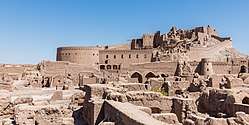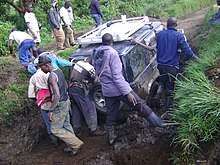Mud
Mud is soil, loam, silt or clay mixed with water. It usually forms after rainfall or near water sources. Ancient mud deposits harden over geological time to form sedimentary rock such as shale or mudstone (generally called lutites). When geological deposits of mud are formed in estuaries, the resultant layers are termed bay muds.
| Look up mud in Wiktionary, the free dictionary. |

Building and construction

Adhesive
In the construction industry, mud is a semi-fluid material that can be used to coat, seal, or adhere materials. Depending on the composition of the mud, it can be referred by many different names, including slurry, mortar, plaster, stucco, and concrete.
Material
Mud, cob, adobe, clay, and many other names are historically used synonymously to mean a mixture of subsoil and water possibly with the addition of stones, gravel, straw, lime, and/or bitumen. This material was used a variety of ways to build walls, floors and even roofs. For thousands of years it was common in most parts of the world to build walls using mudbricks or the wattle and daub, rammed earth or cob techniques and cover the surfaces with earthen plaster.
Mudbrick
Mud can be made into mud bricks, also called adobe, by mixing mud with water, placing the mixture into moulds and then allowing it to dry in open air.[1] Straw is sometimes used as a binder within the bricks, as it makes them a composite. When the brick would otherwise break, the straw will redistribute the force throughout the brick, decreasing the chance of breakage.[2] Such buildings must be protected from groundwater, usually by building upon a masonry, fired brick, rock or rubble foundation, and also from wind-driven rain in damp climates, usually by deep roof overhangs. In extremely dry climates a well-drained flat roof may be protected with a well-prepared (puddled) and properly maintained dried mud coating, viable as the mud will expand when moistened and so become more water resistant.[3] Adobe mudbricks were commonly used by the Pueblo Indians to build their homes and other necessary structures. In some countries there are entire cities made of mud brick houses.
Fired brick
Mud that is mostly clay, or a mixture of clay and sand may be used for ceramics, of which one form is the common fired brick. Fired brick are more durable but consume much more energy to produce.
Stabilized mud
Stabilized mud (earth, soil) is mud which has had a binder such as cement or bitumen added. Examples are mudcrete, landcrete, and soil cement.
Pottery
Pottery is made by forming a clay body into objects of a required shape and heating them to high temperatures in a kiln which removes all the water from the clay, which induces reactions that lead to permanent changes including increasing their strength and hardening and setting their shape. A clay body can be decorated before or after firing. Prior to some shaping processes, clay must be prepared. Kneading helps to ensure an even moisture content throughout the body. Air trapped within the clay body needs to be removed. This is called de-airing and can be accomplished by a machine called a vacuum pug or manually by wedging. Wedging can also help produce an even moisture content. Once a clay body has been kneaded and de-aired or wedged, it is shaped by a variety of techniques. After shaping it is dried and then fired.
In ceramics, the making of liquid mud (called slip) is a stage in the process of refinement of the materials, since larger particles will settle from the liquid.
Habitat
Land
Mud can provide a home for numerous types of animals, including varieties of worms, frogs, snails, clams, and crayfish. Other animals, such as hippopotamuses, pigs, rhinoceroses, water buffalo and elephants, bathe in mud in order to cool off and protect themselves from the sun. Submerged mud can be home to larvae of various insects.
Marine life
Mud plays an important role in the marine ecosystem. The activities of burrowing animals and fish have a dramatic churning effect on muddy seabeds. This allows the exchange and cycling of oxygen, nutrients, and minerals between water and sediment.[4]
Below the surface, the burrows of some species form intricate lattice-like networks and may penetrate a meter or more downwards. This means that the burrowed mud is a productive habitat, providing food and shelter for a wide range of mud-dwellers and other animals that forage in and over the mud.[4]
Problems
.jpg)

Mud can pose problems for motor traffic when moisture is present, because every vehicle function that changes direction or speed relies on friction between the tires and the road surface, so a layer of mud on the surface of the road or tires can cause the vehicle to hydroplane.
Heavy rainfall, snowmelt, or high levels of groundwater may trigger a movement of soil or sediments, possibly causing mudslides, landslides, avalanches, or sinkholes.
Mudslides in volcanic terrain (called lahars) occur after eruptions as rain remobilizes loose ash deposits.[5]
Mudslides are also common in the western United States during El Niño years due to prolonged rainfall. Another problem mud creates is it can prove difficult to get out of if stuck, most bogs are more dangerous than quicksand because you can sink deep in to the mud. You can drown in a peat bog because they are deep patches of water with vegetation on top.
As food
.jpg)
There are numerous dysphemisms for poor-tasting food such as "tastes like dirt". Kava tea is often described this way, as it is bitter, brown, and contains sediments.
There also exist children's recipes for "mud", which is generally a chocolate or cornstarch-based sludge used more for visual appeal than actual taste. Never does this confectionery mud actually contain real mud.[6]
Geophagia
The practice of eating earth or soil-like substances is geophagia.
Recreation
Mud bath
A mud bath is a bath of mud, commonly from areas where hot spring water can combine with volcanic ash. Mud baths have existed for thousands of years, and can be found now in high-end spas in many countries of the world.
Mud wallow
Mud wallows are a common source of entertainment for kids. Mud wallows can be any shape, size, depth and some can have water as well as mud. Usually wallows are shallow dips in the ground that have been flooded and were full of dirt and those two have mixed to make a squishy mud wallow.
Mudding
Mud bogging is a form of off-road motorsport popular in Canada and the United States in which the goal is to drive a vehicle through a pit of mud or a track of a set length. Winners are determined by the distance traveled through the pit. However, if several vehicles are able to travel the entire length, the time taken to traverse the pit will determine the winner.
Mud run
Mud runs are a popular activity involving mud. Participants run a distance of 3 miles to as long as 10 miles, while crawling through mud bogs, and battling other obstacles.[7][8][9]

Other
- Mud is used in mud wrestling as a form of entertainment.
- Mud can be used in a dunk tank.
- Dirt biking involves biking through muddy tracks and courses.
 A rhinoceros taking a 'mud bath'
A rhinoceros taking a 'mud bath' - Baseball Rubbing Mud is used to remove the sheen from new baseballs.
- Children often like to make 'mud pies', throw mud at each other and play barefoot and cover their bare feet in mud and/or coat themselves in mud.
- Albuquerque and other towns across the United States such as Gillette, Wyoming hold a yearly event in which participants play volleyball in a giant mud pit.
- Mud can be smeared across the skin as a repellent from mosquitoes.
- Many animals cover themselves in mud to cool off.
See also
- Drilling mud
- Muck (soil)
- Mudcrack
- Mudcrete
- Mud flap
- Mud volcano
- Peloid
- Mudflat
References
| Wikimedia Commons has media related to Mud. |
| Wikiquote has quotations related to: Mud |
- admin_666 (29 July 2013). "Mud brick". yourhome.gov.au.
- Smith, Michael G. The Cobber’s Companion: How to Build Your Own Earthen Home. Cottage Grove: Cob Cottage, 1998. Print.
- "Preservation Brief 5: Preservation of Historic Adobe Buildings". nps.gov.
- A summary of the ‘Burrowed Mud’ MPA search feature. (n.d.). Retrieved January 13, 2015, from http://webcache.googleusercontent.com/search?q=cache:4-c-IWKEf1kJ:www.scotland.gov.uk/Resource/0039/00394205.doc &cd=3&hl=en&ct=clnk&gl=us
- "Mud on the Move." Earth: The Definitive Visual Guide. London: Dorling Kindersley, 2013. 98. Print.
- "Magic mud food recipe – Magic mud ingredients & cooking". Cookadvice.com. 2 September 2012. Archived from the original on 20 March 2012. Retrieved 26 December 2012.
- "Mud Run – Obstacle Races – Tough Mudder". Tough Mudder. Archived from the original on 15 October 2014. Retrieved 15 October 2014.
- "Cerebrun – Get Mental". Cerebrun. Retrieved 15 October 2014.
- "Warrior Dash – The World's Largest Obstacle Race Series". Warrior Dash. Archived from the original on 12 September 2014. Retrieved 15 October 2014.
Further reading
- P.J. Depetris; P.E. Potter; J.B. Maynard (2005). Mud and mudstones introduction and overview (1 ed.). Berlin [u.a.]: Springer. ISBN 3-540-27082-5.
- Wood, C.E. (2006). Mud a military history (1st ed.). Washington, D.C.: Potomac Books. ISBN 9781612343310.
- C.L.V. Monty; D.W.J. Bosence; P.H. Bridger; B.R. Pratt, eds. (1995). Carbonate Mud-Mounds Their Origin and Evolution. Chichester: John Wiley & Sons. ISBN 1-4443-0412-7.
- Okonkwo, Festus (2009). Introductory Mud Engineering Handbook. Booksurge Publishing. ISBN 9781439227275.
- Rael, Ronald (2009). Earth architecture (1st ed.). New York, N.Y.: Princeton Architectural Press. ISBN 1-56898-767-6.
